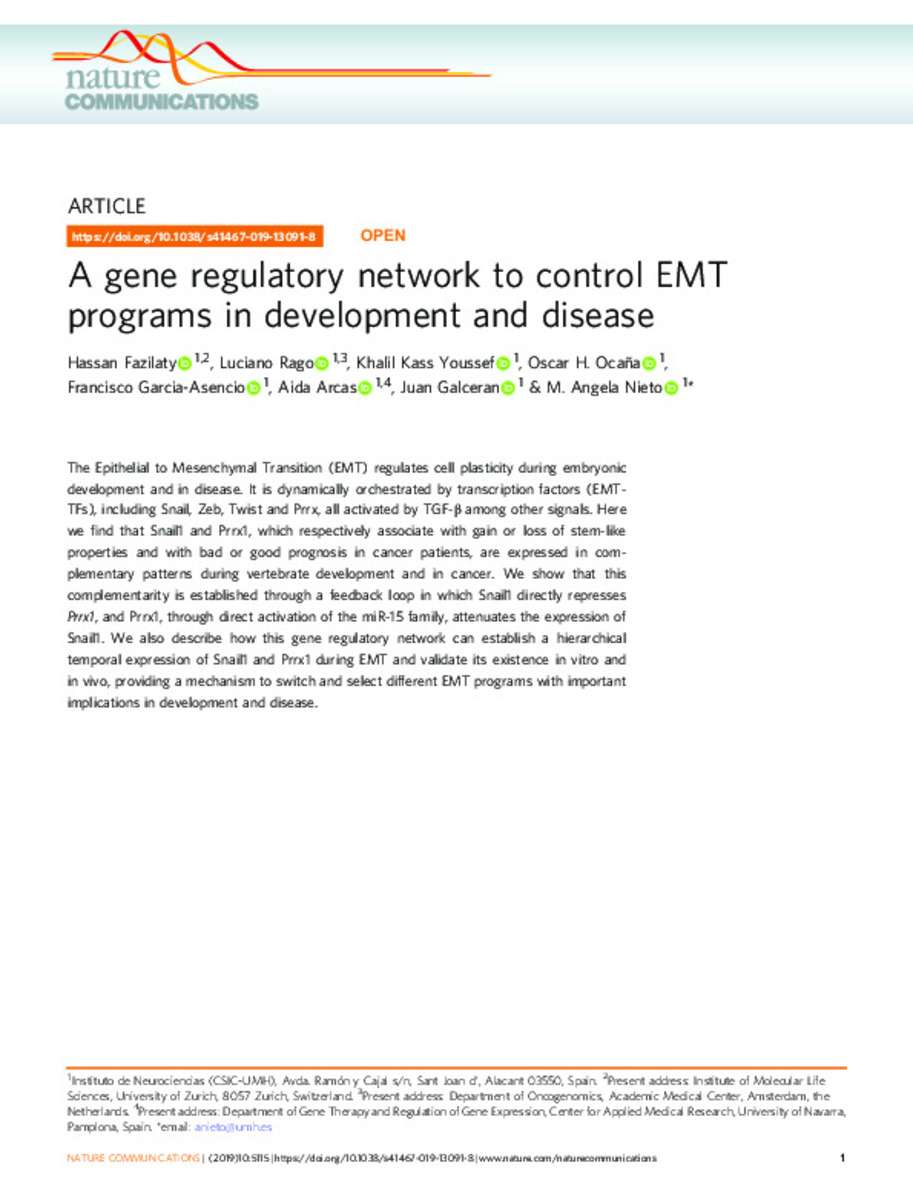Full metadata record
| DC Field | Value | Language |
|---|---|---|
| dc.creator | Fazilaty, H. (Hassan) | - |
| dc.creator | Rago, L. (Luciano) | - |
| dc.creator | Kass-Youssef, K. (Khalil) | - |
| dc.creator | Ocaña, O.H. (Oscar H.) | - |
| dc.creator | García-Asencio, F. (Francisco) | - |
| dc.creator | Arcas, A. (Aída) | - |
| dc.creator | Galceran, J. (Juan) | - |
| dc.creator | Nieto, M.A. (M. Ángela) | - |
| dc.date.accessioned | 2021-11-09T12:08:06Z | - |
| dc.date.available | 2021-11-09T12:08:06Z | - |
| dc.date.issued | 2019 | - |
| dc.identifier.citation | Fazilaty, H. (Hassan); Rago, L. (Luciano); Kass-Youssef, K. (Khalil); et al. "A gene regulatory network to control EMT programs in development and disease". Nature Communications. 10 (5115), 2019, 1 - 16 | es |
| dc.identifier.issn | 2041-1723 | - |
| dc.identifier.other | PMID: 31712603 | - |
| dc.identifier.uri | https://hdl.handle.net/10171/62415 | - |
| dc.description.abstract | The Epithelial to Mesenchymal Transition (EMT) regulates cell plasticity during embryonic development and in disease. It is dynamically orchestrated by transcription factors (EMT-TFs), including Snail, Zeb, Twist and Prrx, all activated by TGF-β among other signals. Here we find that Snail1 and Prrx1, which respectively associate with gain or loss of stem-like properties and with bad or good prognosis in cancer patients, are expressed in complementary patterns during vertebrate development and in cancer. We show that this complementarity is established through a feedback loop in which Snail1 directly represses Prrx1, and Prrx1, through direct activation of the miR-15 family, attenuates the expression of Snail1. We also describe how this gene regulatory network can establish a hierarchical temporal expression of Snail1 and Prrx1 during EMT and validate its existence in vitro and in vivo, providing a mechanism to switch and select different EMT programs with important implications in development and disease. | es_ES |
| dc.description.sponsorship | This work was supported by grants from the Spanish Ministries of Economy and Competitiveness (MINECO BFU2014-53128-R), of Science, Innovation and Universities (MICIU RTI2018-096501-B-I00), Generalitat Valenciana (2017/150) and the European Research Council (ERC AdG 322694) to M.A.N., who also acknowledges financial support from the Spanish State Research Agency, through the “Severo Ochoa” Program for Centres of Excellence in R&D (SEV-2017–0273). H.F. was recipient of PhD student scholarships Santiago Grisolia from Generalitat Valenciana (GRISOLIA/2014/004). L.R. was holder of a Juan de la Cierva Formación postdoctoral scholarship and F.G.A. is recipient of a PhD student scholarship (FPI), both from MINECO. | es_ES |
| dc.language.iso | eng | es_ES |
| dc.publisher | Springer Science and Business Media LLC | es_ES |
| dc.relation | info:eu-repo/grantAgreement/EC/FP7/322694/EU | - |
| dc.rights | info:eu-repo/semantics/openAccess | es_ES |
| dc.subject | Materias Investigacion::Ciencias de la Salud::Genética | es_ES |
| dc.title | A gene regulatory network to control EMT programs in development and disease | es_ES |
| dc.type | info:eu-repo/semantics/article | es_ES |
| dc.description.note | This article is licensed under a Creative Commons Attribution 4.0 International License, which permits use, sharing, adaptation, distribution and reproduction in any medium or format, as long as you give appropriate credit to the original author(s) and the source, provide a link to the Creative Commons license, and indicate if changes were made | es_ES |
| dc.identifier.doi | 10.1038/s41467-019-13091-8 | - |
| dadun.citation.endingPage | 16 | es_ES |
| dadun.citation.number | 5115 | es_ES |
| dadun.citation.publicationName | Nature Communications | es_ES |
| dadun.citation.startingPage | 1 | es_ES |
| dadun.citation.volume | 10 | es_ES |
Files in This Item:
Statistics and impact
Items in Dadun are protected by copyright, with all rights reserved, unless otherwise indicated.






